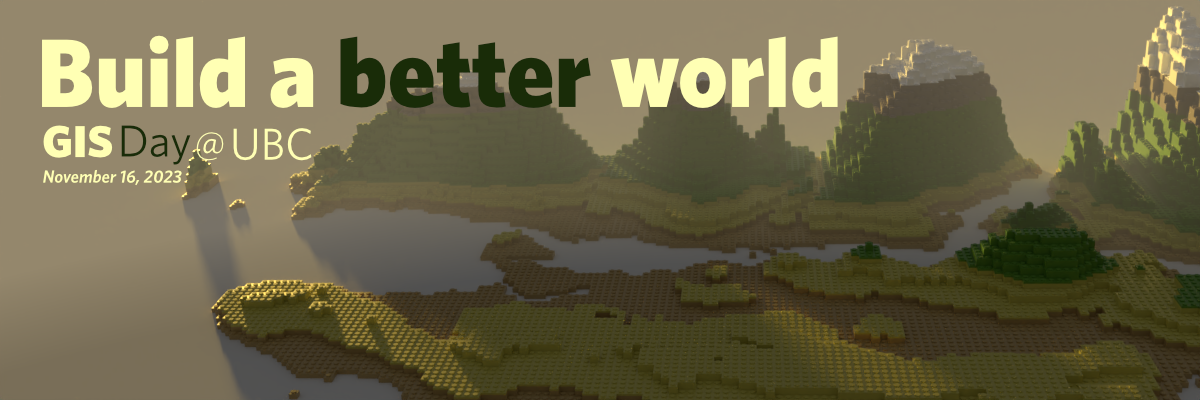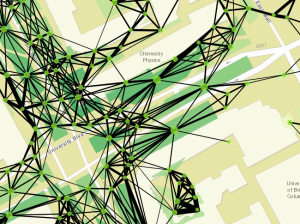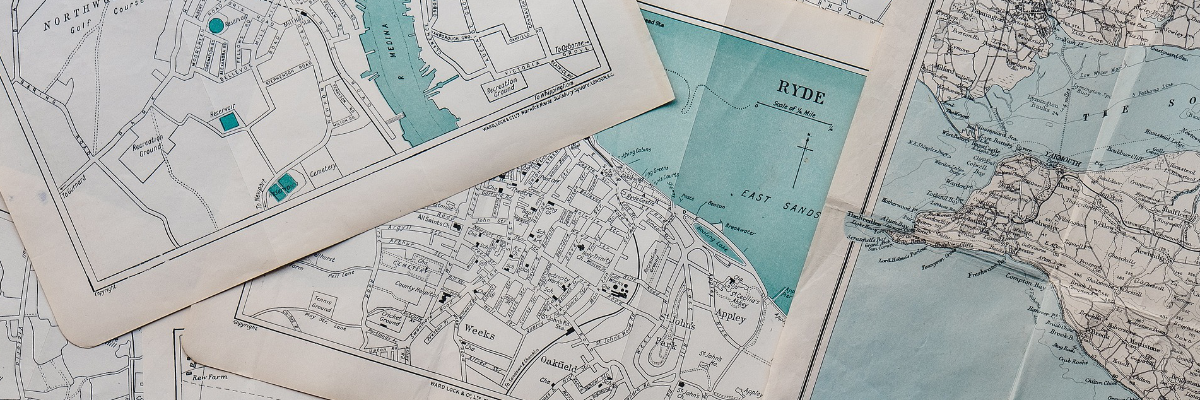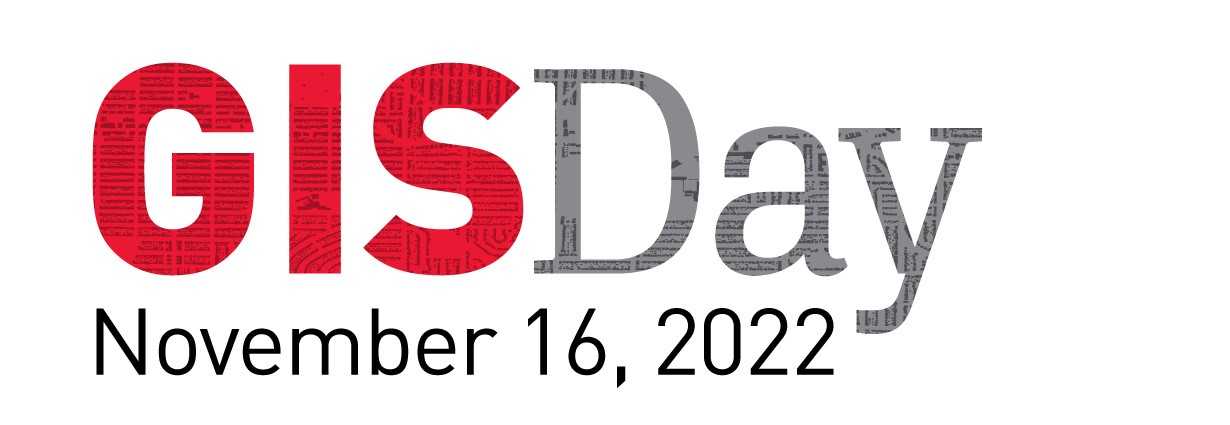GIS Day is an annual worldwide celebration of Geographic Information Systems (GIS) technology and community. Organized by Simon Fraser University Library, University of British Columbia Library, and UBC Faculty of Forestry, GIS Day 2022 will be an online event, to be held via Zoom. The full GIS Day program is below.
Map-making is often privileged as a domain for experts only. Join us for a workshop and conversation that disrupts that! Participatory mapping approaches seek to include and empower communities in mapping their own knowledge. This workshop will be hosted by SFU CERi (Community-Engaged Research Initiative) at 312 Main St, Vancouver, and is open to members of UBC. We hope that this workshop also provides an opportunity for researchers, community members, and students to socialize and learn from each other. Light refreshment will be provided.
You’re invited to participate in an open map editing session to help improve the information found in OpenStreetMap. OpenStreetMap is an openly accessible map-based dataset covering the globe, and is built and maintained by volunteers. Join us as we guide you through the steps to edit OpenStreetMap data and submit your changes for the next steps in quality control. The session will begin by a short introductory session by UBC Geography Students’ Association YouthMappers chapter, so everyone will become familiar with the editing process. No previous experience is necessary. Information to learn more about OpenStreetMap will be emailed to registrants before the event.
No software technical requirements are necessary, other than to have a good internet connection and an internet browser, such as Google Chrome or Mozilla Firefox.
8:50 am – 9:00 am
Welcome
9:00 am – 9:20 am
A Collaborative Model for Data Sharing
Steve Mark, Eden McDonald-Yale, Integrated Cadastral Information Society (ICIS)
Steve Mark is Director of Operations, and Eden McDonald-Yale is Stakeholder Engagement Coordinator at Integrated Cadastral Information Society (ICIS). Their presentation is about the benefits of sharing geospatial data across different organizations, offering insights into the Society’s unique collaborative model.
The Integrated Cadastral Information Society (ICI Society) is a leader in sharing geospatial information, promoting the integration, adoption, and use of spatial data for the social and economic benefit of British Columbians. In addition to data sharing, ICI Society works to facilitate opportunities for training, education, and collaboration across government, industry, and other interested organizations. Incorporated in May 2001 and registered under the BC Societies Act as a non-profit organization, the Society works to integrate spatial data from its 309 members across the province – which include 184 local governments, 75 First Nations, 12 utility companies, 15 Associate members, and all provincial government ministries. As a single source for data from multiple agencies, the Society continues to keep members connected, supplied, and engaged with data products and services that align with ICI Society’s vision. Unique to the ICI Society model is its commitment to collaboration; focused relationship-building, opportunities for education and training, and a granting program for members to perform data quality improvements have been key to the Society’s widespread success over the last two decades.
9:20 am – 9:40 am
Automated “Dial Before You Dig” (BC1C)
Herman Louie, City of Burnaby
As the third largest city in British Columbia, Canada, the City of Burnaby has experienced exponential growth in the past two decades. The total number of requests received throughout the entire year in 1994 was 140, compared to a record number of 102 received in a single day on June 7, 2018. Bound by provincial legislation, the city then has three business days to turnaround an underground information package to the homeowner or contractor. An increase of development within the lower mainland had overloaded City staff and increased the timelines of supplying underground information package to our clients. For example, in 1994 the City of Burnaby had 140 information package requests for the year. By 2017, the volume of information package requests made to the City of Burnaby had increased to 8,469! That’s an increase of over 6,000% in 23 years. This increase in demand resulted in a longer than desired turnaround time for the underground information packages. In the past it could take hours or days to get the packages, with the new automated process, it is down to about three minutes! Using the data integration software called FME Server, the GIS team was able to meet this demand with an automated “BC One Call” system by extracting information from our GIS and Asset Management Systems. Some of the benefits of this solution include increased staff focus on other value-added services, no risk of legislative requirements not being met by delays in getting the underground information packages to clients on time, and enhanced customer benefits by quicker (almost immediate) receipt of the underground information packages. https://www.youtube.com/watch?v=UxCpb1LlXLE
9:40 am – 9:50 am
Q&A
9:50 am – 10:00 am
Break
10:00 am – 10:20 am
Teaching GIS with video games in immersive digital twin worlds
Paul Pickell, UBC
Paul Pickell is an Assistant Professor of Teaching of geomatics at the UBC Faculty of Forestry. He teaches GIS in several undergraduate and graduate programs and leads the development of immersive virtual reality, augmented reality, and web-based mapping applications for teaching GIS at UBC.
The metaverse is a proposed next evolution of the internet, involving the creation of “digital twin” environments that are virtual representations of the real world where people can interact in virtual reality. There are a wide-range of unexplored applications for an educational metaverse such as virtual field trips, creative sandbox play, and exploration-based learning. Game engines are a logical entry point into a metaverse because they provide the basis for simulating real-world environments including processes such as Sun position, lighting, shading, atmosphere, clouds, weather, gravity, and vegetation growth among many other processes. Minetest is a Free and Open Source Software clone of the popular Minecraft voxel-based sandbox video game. The appeal of this gameplay is the ability to build anything you can imagine including buildings and machines out of blocks that can be mined. Voxel-based video games are ideal for visualizing geographic data because it is relatively easy to convert mapped data into voxels. Additionally, first-person video games like Minetest provide low-barrier entry to 3D data exploration and visualization with intuitive movement and controls. In this presentation, I will show how geospatial data can be converted into digital twin worlds in Minetest for the UBC Vancouver campus and the UBC Malcolm Knapp Research Forest. I will discuss recent examples of teaching GIS with these digital twin worlds in Minetest at UBC and conclude with how this technology can be adopted in GIS classrooms.
10:20 am – 10:40 am
Student-led design and development of GIS labs for teaching Forestry
Paul Pickell, Honghong Li, Marcellus Wang, Kailey Chelswick, Han Yan, UBC
Geomatics is a rapidly advancing field with constant technological and software changes, which make it challenging to ensure that instructional labs are up-to-date and relevant for teaching and learning. GIS educators will recognize the significant burden of continuously updating lab instructions to accommodate the evolving GIS technology and interests of students. We describe a student-led approach to developing new GIS lab topics for teaching GIS in the Faculty of Forestry. We produced four new GIS labs:
-
Urban green space equity – The unequal distribution of urban forests in cities is associated with many socioeconomic factors such as income level. Students will explore the greenery status in Metro Vancouver to better understand what factors contribute to inequality of access to green space using proximity tools.
-
Historical redlining legacies – As a discriminatory zoning system, redlining not only influenced the neighbourhood living style in the last century but also impacted the current urban setting such as greenspace allocation, green gentrification, and public well-being study. Students will explore specific city characteristics using overlay tools.
-
Wildfire burned area – La Niña has affected BC for three years and has caused more intense drought and increased the risk of wildfires. Students will learn about the frequency of wildfires in BC in recent years and learn how to search, download, and manage public geospatial data sources.
-
Cloud computing – Western mountain pine beetle has been severely damaging pine forests in the BC interior and in places in Alberta. Students will use Google Earth Engine to determine the areas in Jasper National Park that experienced a decrease in vegetation health.
In addition to describing the workflows for the labs above, we detail our process and lessons learned for undertaking this collaborative and student-led process for developing new GIS labs.
10:40 am – 10:50 am
Q&A
10:50 am – 11:00 am
Break
11:00 am – 11:20 am
Reroutes of the Pacific Northwest National Scenic Trail Near Hannegan Pass
Lauren Holzman, UBC
The Pacific Northwest Trail (PNT) is among the newest of the 11 national scenic trails, stretching from Montana to the Washington Coast. Given the recent history of the trail, parts are still under construction, and currently, over 10% of the trail consists of highway walking. In an effort to reduce this percentage, the Pacific Northwest Trail Association (PNTA), in conjunction with the US Forest Service (USFS) is working to reroute sections that are currently along highways to trails. This analysis looks at a particular location for which the PNTA is currently examining and determines the best possible location to build the new section of trail. The location is just West of Hannegan Pass in the Mount Baker-Snoqualmie National Forest, where the trail currently travels along Highway 542 (the Mount Baker Highway). To do this, least-cost path analysis is used, taking into account multiple different factors that impact trail longevity as well as aesthetic appeal. The results are compared for two different endpoints as well as results with and without the implementation of a geographic restriction. In doing so, the recommended routes are produced.
11:20 am – 11:25 am
Lightning talk:Trucks with Lasers: Mapping the Wilderness
Jay H. Matsushiba, SFU
LiDAR, AI, computer vision, and photogrammetry have become powerful components of autonomous vehicle systems. However, these technologies also offer considerable potential for real-time geospatial sensing and data generation, and post-processing contexts, in support of human-controlled vehicle operations in unprepared, remote field environments. Across Canada, landscapes that are remote and difficult to access, are becoming increasingly significant to characterize – in order to support indigenous communities, monitor remote trans-continental railroads, survey locations for renewable energy infrastructure development – in places that have previously been deemed prohibitively inaccessible. New vehicle systems are emerging that are capable of reaching these places. With their emergence come practical needs to enhance the physical capabilities of these systems, with 21st century sensing and data acquisition capabilities – to support real-time vehicle navigation, route planning, and geomorphometric hazard assessment. Closely linked to this, is the opportunity to also generate new high-resolution datasets of the landscapes that are traversed, as vehicles pass through them. This project – a collaboration between SFU’s Spatial Interface Research Lab, and KXI technologies – explores two themes of emerging geographical sensor and geovisual interface technologies (EGT) to elevate vehicle sensing and data acquisition from vehicle platforms in remote places. First, we will build and test sensor systems added to vehicles that are designed to extend and elevate driver spatial perception and situational awareness when navigating remote landscapes. Second, we will explore ways to simultaneously generate new 3D datasets from these moving vehicle platforms, using active and passive sensing technologies, and explore ways in which we may begin to mobilize these data, using new interface technologies.
11:25 am – 11:30 am
Lightning talk:Delineating Grassland in British Columbia
Tsz Wing, Ng (Jackie), UBC
Grassland is an endangered ecosystem that cover 30% of the earth surface but didn’t catch ecologists’ attentions till 1990s (Gayton, 2003). Decline of grassland are due to development of cropland and pastures (Bardgett et al., 2021). In British Columbia (BC), it also resulted from forest encroachment and introduction of invasive species because of the fire suppression policy in 19th century (Dickson‐Hoyle et al., 2022). Conventional grassland monitoring practices only help rangers to manage grassland in a confined area. A province-wide study in mapping grassland is necessary for reviewing management approaches and drafting restoration plan. Yet, relevant inventory is incomplete and discrete in BC. Researchers have been mapping and monitoring grasslands by geomatic approaches (Reinermann et al., 2020). Grassland cover is determined through supervised or unsupervised machine learning classifier based on vegetation indices while phenology is studied by analyzing multitemporal satellite images (Reinermann et al., 2020). Challenge of mapping grassland lay in differentiating cover classes with inconspicuous differences in their vegetation indices, such as grassland and hay fields (Frank et al., 2022). My capstone project is going to map grassland annually through an automated tool. Common indices in monitoring vegetation cover will be derived from Copernicus Sentinel data, processed by ESA, over a pilot study area. 3 key indices will be identified by Random Forest (Breiman, 2001). We will map grassland in the study area by object-based supervised classifiers, including Random Forest (Breiman, 2001) and support vector machine (Boser et al., 1992). Multitemporal data (McInnes et al., 2015) and comparative triangles (Frank et al., 2022) will be incorporated in classifying objects with similar spectral signature. Grassland cover over the province will be mapped by the best model Stewardship of grassland in BC can identify critical ecotones and draft strategic management plans accordingly from the results.
11:30 am – 10:40 am
Q&A
11:40 am – 1:00 pm
Lunch Break
1:00 pm – 1:20 pm
ArcGIS in gerontology: exploring the lived experiences of people with dementia at the neighborhood scale
Mohammadjavad Nouri, SFU
In Canada, there is limited empirical evidence on the role of neighborhood built environmental features in supporting mobility and participation for people living with dementia (PLWD). Municipalities, dementia advocacy organizations, and the general public do not have any specific tools and resources for raising awareness about the importance of neighborhood built environments for PLWD. Dementia-inclusive Streets and Community Access, Participation, and Engagement (DemSCAPE) project focuses on the spatial dimensions of the lived experience of PLWD at the neighborhood scale. This project aims to examine the role of built environment features in providing a supportive neighborhood socio-physical environment for PLWD. A total of 30 community dwelling PLWD in Metro Vancouver and Prince George in British Columbia are targeted for participation in this project. To collect spatial data, sit-down and walkalong interviews are used. Preliminary findings indicate that PLWD’s walking routes from their homes to their most common destinations was the most experienced neighborhood space. For collecting spatial data related to walking routes, several ArcGIS software and platforms are used. The project geodatabase and 30 feature datasets for participants are provided in ArcGIS Pro. With the help of ArcGIS Online, the field researchers were able to access created feature datasets for use in Field Map application to record spatial features, take notes, and take photographs while conducting walking interviews. The walking route and its characteristics have been recorded using the ArcGIS tracker application. Additionally, participants have recorded geotagged videos of their walking experiences using GoPro cameras. As part of the analysis phase, ArcGIS Pro is used for visualizing the codes extracted from interviews attached to the spatial features. With the help of the video multiplexer tool in the ArcGIS Pro environment, spatial dimensions are given to participants’ feelings, knowledge and experiences through the creation of related spatial features.
1:20 pm – 1:40 pm
GIS in SFU Facilities Services
Jessica Li, SFU
SFU Facilities Services has been using GIS technology since 2011. In the past few years, we have built various GIS datasets and applications, such as utilities data, planning maps and operation apps as well. The presentation will showcase some of the GIS applications and address how GIS helps SFU in facilities management and campus planning.
1:40 pm – 1:50 pm
Q&A
1:50 pm – 2:10 pm
Regional Seismic Risk for Dense Urban Centers in Vancouver
Preetish Kakoty, UBC
Southwestern Canada is exposed to the Cascadia subduction zone that can produce large magnitude (~M9) earthquakes that can affect communities across Vancouver Island and Metro Vancouver region. Earthquake risk in the Metro Vancouver region is exacerbated by the underlain sedimentary basin that amplifies shaking intensity and the high density of older tall buildings that were constructed prior to the advent of modern building codes. Due to the paucity of empirical data of ground shaking due to earthquakes from the Cascadia subduction zone, the impact of an inevitable future earthquake in the Metro Vancouver region is largely unknown. To this end, we develop a regional seismic risk model to estimate economic loss, post-earthquake housing recovery, etc. to aid risk-informed policy making for effective mitigation strategies. We use numerical models to estimate risk metrics for a scenario M9 Cascadia subduction zone earthquake and utilize Geospatial Information Systems (GIS) to analyze and visualize spatial variations of appropriate risk metrics. Post-earthquake housing recovery time is quantified using this framework for the West End neighborhood of the City of Vancouver, which has a high concentration of pre-1990 tall RCSW buildings that are identified to be vulnerable due to non-ductile thin shear walls. Although, this taxonomy of building is not the only source of risk but they disproportionately contribute to regional risk due to high occupancy levels and dated construction practices. GIS provides a powerful platform for identifying regions of high risk and exploring effectiveness of mitigation strategies on regional risk.
2:10 pm – 2:30 pm
After the flames: leveraging the power of GIS to predict future wildfire-related risks
Brendan P. Murphy, SFU
Geospatial analysis provides a diversity of data, methods, and tools that can be used to address critical environmental problems facing society. However, standard, “off-the-shelf” GIS tools can only get us so far. While this limits the utility for many end-users, this gap presents exciting research opportunities for developing useful new GIS tools. My research focuses on the impacts of increasing wildfire activity across western North America, with a primary objective of improving models of erosion, flooding, and geohazards after wildfire to better predict risks to natural resources, infrastructure, and ecosystems. These processes and their impacts are spatially explicit, and the factors controlling them are fundamentally linked to spatial characteristics of topography, land cover, burn conditions, meteorology, etc. This makes GIS essential in nearly every research step, from mapping to data analysis and modeling. Although numerous empirical and statistical models exist to predict post-wildfire impacts, there are presently no resources that integrate them all into a single, comprehensive framework. Additionally, most existing models do not represent actual or available scripts or tools that can be readily implemented, particularly at large spatial scales. This presentation provides an overview of new geospatial resources my research group has developed for the analysis and prediction of wildfire-related processes and their associated impacts. This work leverages both ArcGIS and Google Earth Engine and involves methods in geostatistics, remote sensing, and coding Python-based, GIS tools. Specifically, we developed a new machine-learning model for predicting wildfire severity, a fully-automated GIS toolkit for hydrogeomorphic watershed delineation, and a modeling framework for integrated post-wildfire erosion and geohazard prediction. Finally, the utility of these tools is demonstrated in a real-world application predicting the vulnerability of water supply reservoirs to sediment infilling after wildfire.
2:30 pm – 2:50 pm
Colorweaving: Thematic mapping for the complexities of geography
Luke Bergmann, UBC, and David O’Sullivan, Victoria University of Wellington
Often, we analyze and map the world via a variable or two of interest. How might the world look if we insisted on representing it to ourselves as more multifaceted? We have been developing a set of techniques inspired by weaving and tiling to facilitate understanding landscapes in ways that embrace both synthesis and analysis. We will present our work, a software library that we have been creating, and some example applications that we have found interesting and helpful in working through the possibilities.
2:50 pm – 3:00 pm
Q&A
For more information please contact Evan Thornberry (evan.thornberry[at]ubc.ca).

 GIS day 2023 is coming soon! Join us on November 16th, 2023 at the Dodson Room, Number 302, Third Floor, of the Irving K Barber Learning Centre at the University of British Columbia Vancouver campus.
GIS day 2023 is coming soon! Join us on November 16th, 2023 at the Dodson Room, Number 302, Third Floor, of the Irving K Barber Learning Centre at the University of British Columbia Vancouver campus.

